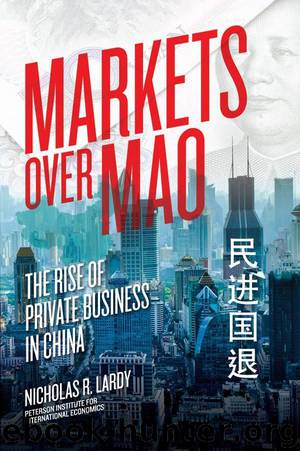Markets Over Mao: The Rise of Private Business in China by Nicholas Lardy

Author:Nicholas Lardy
Language: eng
Format: mobi
Publisher: Institute for International Economics,U.S.
Published: 0101-01-01T00:00:00+00:00
Figure 3.4 Retained corporate earnings as a share of corporate investment, 1992–2011
Note: Retained earnings are the disposable income of nonfinancial corporations reported in the flow of funds.
Sources: National Bureau of Statistics of China (2013c, 80–81); ISI Emerging Markets, CEIC Database.
Faster growth of factor productivity in private firms has translated into much stronger financial performance. The OECD study found that private firms were able to maintain their earnings at a relatively high share of value added and that their return on assets and return on equity increased substantially between 1999 and 2003. In 2003 private companies’ average return on both assets and equity was about half again as high as state firms’ returns (OECD 2005, 87, 99). The World Bank also found a significantly higher return on equity by nonstate firms during the period 1998–2009. By 2009 the gap was huge, with nonstate firms’ returns on equity at 20 percent, running 9.9 percentage points ahead of state firms (World Bank 2012, 111). Similarly, David Dollar and Shang-Jin Wei (2007), based on a survey of a random sample of 12,400 firms conducted in 2002–03, found that private firms’ average return to capital was half again as high as that of wholly state-owned firms and also well above returns of majority and minority state-owned firms.
Data for the industrial sector going back to the mid-1990s, shown in figure 3.5, demonstrate that registered private enterprises consistently have earned a higher return on assets than the combined universe of state-owned enterprises and state-controlled firms.52 The reforms of the state-owned industrial sector analyzed in chapter 2 and the increased competition as a result of China’s entry into the World Trade Organization did lead to a very substantial improvement in the efficiency of these firms for a decade after 1998. The return on assets in state firms rose from a mediocre level of less than 1 percent in 1997–98 to a peak of 6.8 percent in 2007. But even at this peak, registered private firms were much more efficient, recording a return on assets of 9.5 percent. Since then, with the exception of 2010, performance at state firms has fallen, hitting 4.9 percent in 2012. In contrast, except in 2009 and 2012, returns at registered private firms have continued to rise. Thus the margin in favor of privately registered firms has widened dramatically since the mid-2000s. By 2012 the gap was almost three to one.
There are no time-series data that would allow the calculation of return on assets of state and private firms in the service sector. But data in the 2008 economic census support two points: that the return on assets of state enterprises in the service sector is substantially below the returns that state industrial firms earn and that the performance of state firms in services is far inferior to service firms with other forms of ownership.53
Download
This site does not store any files on its server. We only index and link to content provided by other sites. Please contact the content providers to delete copyright contents if any and email us, we'll remove relevant links or contents immediately.
| Arms Control | Diplomacy |
| Security | Trades & Tariffs |
| Treaties | African |
| Asian | Australian & Oceanian |
| Canadian | Caribbean & Latin American |
| European | Middle Eastern |
| Russian & Former Soviet Union |
The Secret History by Donna Tartt(18852)
The Social Justice Warrior Handbook by Lisa De Pasquale(12143)
Thirteen Reasons Why by Jay Asher(8800)
This Is How You Lose Her by Junot Diaz(6796)
Weapons of Math Destruction by Cathy O'Neil(6148)
Zero to One by Peter Thiel(5690)
Beartown by Fredrik Backman(5600)
The Myth of the Strong Leader by Archie Brown(5427)
The Fire Next Time by James Baldwin(5250)
How Democracies Die by Steven Levitsky & Daniel Ziblatt(5129)
Promise Me, Dad by Joe Biden(5088)
Stone's Rules by Roger Stone(5027)
A Higher Loyalty: Truth, Lies, and Leadership by James Comey(4846)
100 Deadly Skills by Clint Emerson(4841)
Rise and Kill First by Ronen Bergman(4705)
Secrecy World by Jake Bernstein(4651)
The David Icke Guide to the Global Conspiracy (and how to end it) by David Icke(4628)
The Farm by Tom Rob Smith(4439)
The Doomsday Machine by Daniel Ellsberg(4419)
